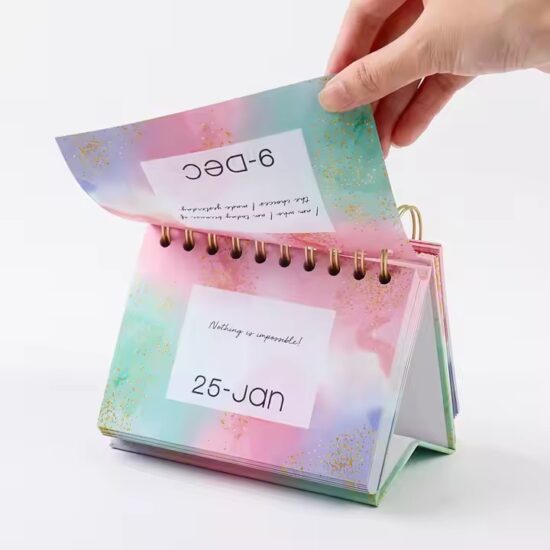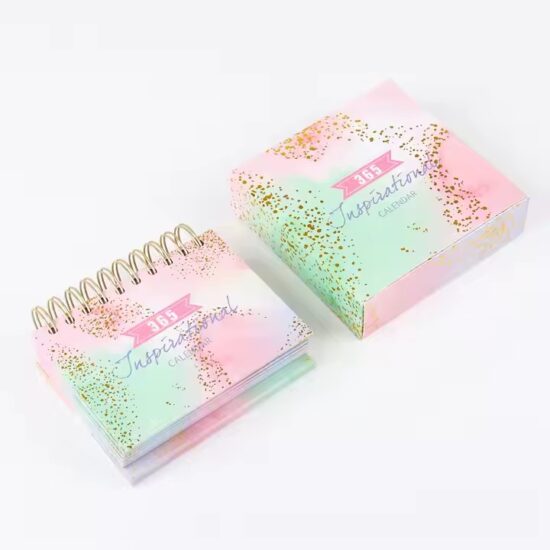bob@nbdho.com
How to Choose High-Quality Materials for Desk Calendars: A Manufacturer’s Guide
📚 How to Choose High-Quality Materials for Desk Calendars: A Manufacturer’s Guide
When it comes to desk calendars, material quality can make or break your product. Whether you’re a manufacturer, wholesaler, or brand offering custom calendars, selecting the right materials is essential for ensuring durability, visual appeal, and customer satisfaction.
In this guide, we break down the key material components and how to choose them for premium calendar production in 2025 and beyond.
📄 1. Paper Type: Striking the Right Balance
The paper is the most visible and tactile part of the calendar. The right paper sets the tone for the entire product—whether you’re aiming for sleek professionalism or artistic elegance.
Common Options:
-
Coated Paper (Glossy/Silk/Matte): Ideal for vibrant image printing (e.g. photo calendars).
-
Uncoated Paper: More natural feel; easier to write on.
-
Recycled Paper: Eco-friendly, growing in demand.
✅ Tip: Choose 120–180gsm for monthly pages and 250–350gsm for covers.
📚 2. Cover Material: First Impressions Matter
The cover protects the calendar and also conveys its branding and quality. You can choose from several materials based on target audience and product purpose.
Popular Choices:
-
Artboard (Gloss/Matt Lamination): Common for promotional calendars.
-
Linen Textured Board: Adds a touch of elegance and tactility.
-
Kraft Paper or Recycled Board: For a rustic or eco-conscious appeal.
✅ Tip: Consider spot UV, foil stamping, or embossing to elevate the cover design.
📌 3. Binding Style: Durability and Usability
Binding affects how easily users can flip through the calendar and how long it lasts with daily use. For desk calendars, the binding must be both strong and convenient.
Most Common Binding Methods:
-
Wire-O Binding (Double Loop): Strong, stylish, and allows full flat opening.
-
Spiral Binding: Cost-effective and functional, often used for budget-friendly options.
-
Tear-off Pad Style (with backing board): Used in flip calendars or daily tear-away formats.
✅ Tip: Use thicker wires (e.g. 3/4″ or more) for calendars with heavy or high-page-count formats.
🧱 4. Base Material: Stability and Presentation
The base supports the calendar, especially for tent-style or triangle desk calendars. The sturdiness of the base determines how well the calendar stands over time.
Recommended Materials:
-
Rigid Greyboard (1000–1500gsm): Industry standard for strong, upright support.
-
Reinforced Cardboard: For lighter formats or smaller calendars.
-
Wooden Bases: Premium or eco-style calendars.
✅ Tip: Wrap the base in printed art paper or colored stock for better branding and finish.
🌱 5. Eco-Friendly Options: A Growing Priority
More customers now prefer sustainable calendars. Choosing eco-conscious materials not only reduces environmental impact but also boosts your brand reputation.
Sustainable Materials Include:
-
FSC-certified paper
-
Soy or vegetable-based inks
-
Recycled boards and packaging
-
Biodegradable laminates
✅ Tip: Highlight eco-materials on your packaging or product pages—it’s a great marketing point.
🖨️ 6. Printing Techniques: Enhancing Color and Clarity
Material selection must align with the type of printing. For example, coated papers work well with photo printing, while uncoated papers pair better with minimalist, text-heavy designs.
Common Methods:
-
Offset Printing: Best for high-volume, full-color jobs.
-
Digital Printing: Ideal for small runs and personalized calendars.
✅ Tip: Conduct print tests before final production to ensure color accuracy and ink behavior.
🧠 Final Thoughts
Choosing high-quality materials for your desk calendars is not just about appearance—it’s about functionality, brand perception, and long-term use. Whether you’re producing in bulk for corporate giveaways or crafting custom premium products, attention to material detail sets your calendar apart in a competitive market.
✅ Quick Checklist for High-Quality Desk Calendars:
-
✔️ Strong, smooth-turning binding
-
✔️ Sturdy base that won’t collapse over time
-
✔️ Paper that is easy to write on and print-ready
-
✔️ Cover that reflects your brand’s quality
-
✔️ Consideration for eco-friendliness and recyclability

